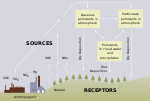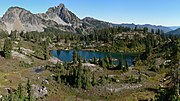 | Theophrastus (redirect from On the Causes of Plants) His two surviving botanical works, Enquiry into Plants (Historia Plantarum) and On the Causes of Plants, were an important influence on Renaissance science... 56 KB (6,555 words) - 04:45, 23 April 2024 |
 | Botany (redirect from Study of plants) as the "Father of Botany". His major works, Enquiry into Plants and On the Causes of Plants, constitute the most important contributions to botanical... 136 KB (14,353 words) - 10:36, 19 April 2024 |
 | Plants that produce toxins and/or cause irritation on contact are referred to as poisonous plants. The toxins in poisonous plants affect herbivores, and... 141 KB (4,899 words) - 05:35, 27 March 2024 |
 | fungi and some of the algae. By the definition used in this article, plants form the clade Viridiplantae (green plants), which consists of the green algae... 94 KB (8,002 words) - 22:45, 7 April 2024 |
 | Critically Endangered (section Causes) the native species' extinction or causing them to become endangered, which also eventually causes extinction. Plants and animals may also go extinct due... 7 KB (788 words) - 14:35, 9 March 2024 |
 | also reduce the presence of the plant "Cotula sessilis (Ruiz & Pav.) Stace | Plants of the World Online | Kew Science". Plants of the World Online. RBG Kew... 4 KB (480 words) - 19:17, 5 July 2023 |
 | Medicinal plants, also called medicinal herbs, have been discovered and used in traditional medicine practices since prehistoric times. Plants synthesize... 77 KB (7,679 words) - 03:34, 12 April 2024 |
 | Olive (redirect from List of olive diseases) who had grown envious of her; but Athena and Gaia turned her into an olive tree as reward. Theophrastus, in On the Causes of Plants, does not give as systematic... 101 KB (10,970 words) - 13:36, 25 April 2024 |
 | Lithops (redirect from Stone Plants) stone-like appearance of the plants. They avoid being eaten by blending in with surrounding rocks and are often known as pebble plants or living stones. Lithops... 22 KB (2,153 words) - 15:28, 7 November 2023 |
 | Auxin (category Plant physiology) in plants, from the cellular level, through organs, and ultimately to the whole plant. When a plant cell comes into contact with auxin, it causes dramatic... 44 KB (5,115 words) - 14:12, 22 April 2024 |
 | Fasciation (category Plant morphology) has been demonstrated as one cause of fasciation, such as in sweet pea (Lathyrus odoratus) plants, but many fasciated plants have tested negative for the... 13 KB (1,104 words) - 22:38, 25 December 2023 |
 | damage plants but are considered a nuisance. Usually, larvae do not cause serious plant damage, but when present in large numbers can stunt the plant growth... 7 KB (755 words) - 15:16, 5 April 2024 |
 | Acid rain (redirect from Acid rain's effect on plants) power plants to a combined total of 8.7 million tons of sulfur dioxide. One power plant in New England (Merrimack) was in Phase I. Four other plants (Newington... 82 KB (8,999 words) - 00:48, 23 April 2024 |
in plants is damage caused by other organisms or by the non-living (abiotic) environment to plants. Animals that commonly cause injury to plants include... 14 KB (1,480 words) - 18:57, 11 April 2024 |
 | Poison ivy (redirect from Poison ivy (plant)) pentadecyl catechols of the oleoresin within the sap of poison ivy and related plants causes the allergic reaction; the plants produce a mixture of pentadecylcatechols... 17 KB (1,734 words) - 07:45, 11 March 2024 |
 | Ecological succession (redirect from Plant succession) of the plant association". Bulletin of the Torrey Botanical Club. 53 (1): 7–26. doi:10.2307/2479933. JSTOR 2479933. Cowles HC (1911). "The causes of vegetational... 49 KB (5,814 words) - 23:29, 7 April 2024 |
 | Transpiration (redirect from Plant transpiration) no energy expense by the plant. Transpiration also cools plants, changes osmotic pressure of cells, and enables mass flow of mineral nutrients. When water... 19 KB (2,349 words) - 17:43, 14 March 2024 |
Orange. Tobacco smoking is associated with many forms of cancer, and causes 80% of lung cancer. Decades of research has demonstrated the link between tobacco... 60 KB (6,775 words) - 17:12, 22 April 2024 |
 | Historia Plantarum (Theophrastus book) (redirect from Enquiry into Plants) preserving fragments of books otherwise lost. He mentions about 500 species of plant. The Enquiry into Plants (along with the Causes of Plants) was first translated... 28 KB (3,466 words) - 00:16, 26 December 2022 |










